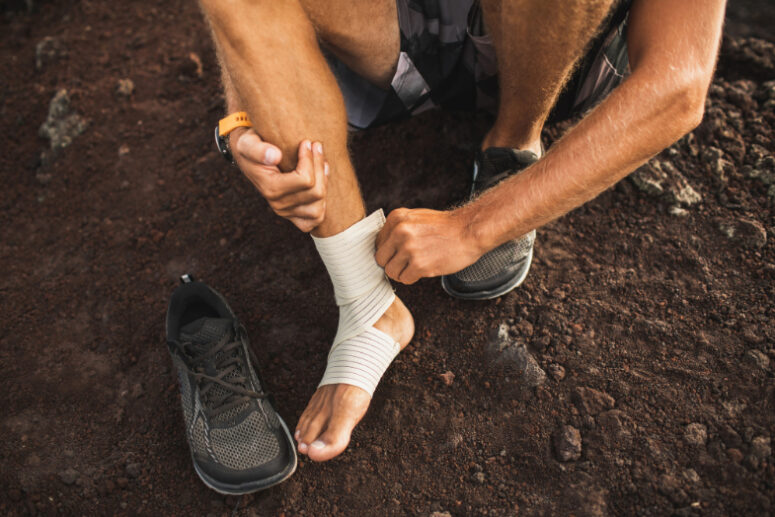Method to Ace Bandage Your Ankle
A compression wrap or Ace bandage can prevent active swelling in a part of your body. Some common locations of the body to apply one are the chest area, wrists, and ankles. They can provide impactful relief from sprains, swelling, blood flow issues, and more. Made of elastic, these devices wrap around the affected area to apply effective pressure and achieve desired results. In some instances, an Ace bandage can also provide a long-term solution to a health concern, such as those related to circulation or blood clots. In this article, we’ll discuss how to treat a rolled ankle, how to effectively wrap a sprained ankle, and the benefits of an Ace bandage for your ankle. With more clarity on treatment options for a rolled or sprained ankle, you can have impactful relief.
 How to Treat a Rolled Ankle
How to Treat a Rolled Ankle
A rolled ankle, otherwise known as a sprained ankle, exists as a bodily injury occurring from you rolling, turning, or otherwise twisting an ankle unnaturally or awkwardly. This action can tear or stretch the ligaments that hold your ankle bones together. These ligaments work to effectively help stabilize your ankle joints, preventing any potentially excessive movements. A rolled ankle occurs when these ligaments experience force beyond their usual range of motion. Most rolled ankles involve one or more injuries to the outer side of your ankle. The treatment options for these ankle injuries can depend somewhat on the particular severity of your given condition. Although over-the-counter medications and self-care can often provide relief, a medical evaluation can reveal the precise severity and best treatment options.
Without proper treatment and ultimate rehabilitation, your injured ankle could lose a degree of its stability and range of motion or may not ultimately heal well. These factors can contribute to recurrent sprains and increased downtime in the long run. Depending on the particular severity of your condition, you can have a longer recovery time. If you have no tearing and minimal ligament stretching with mild pain, tenderness, swelling, or joint instability, you can recover in one to two weeks. If you have a partial tear with moderate pain, bruising, loss of motion, and trouble bearing weight, recovery may be three to six weeks. For a full rupture or tear with severe pain, instability, and inability to bear weight, recovery can be several months. In addition to treating with rest, ice, and elevation, another effective treatment option involves an ankle wrap.
 How to Wrap a Sprained Ankle
How to Wrap a Sprained Ankle
Learning how to wrap a sprained ankle with an ankle wrap can help the afflicted area feel impactful relief. However, this particular device does not prevent an ankle from moving or provide it with significant support. It doesn’t provide protection beyond reminding you to care for your ankle and take other treatment steps as advised. To use an ankle wrap, you’ll begin by unrolling the elastic bandage and holding your ankle up at a 90-degree angle. Starting where your toes meet the rest of your body, hold the loose bandage end at the side of your foot and wrap around the ball of your foot. Be sure to keep the bandage taut with a light pull. After this step, start slowly circling the bandage around your foot’s arch, pulling it diagonally from the bottom of your toes across the top of your foot and around your ankle.
Following these movements, proceed to bring your Ace bandage across the top of your foot diagonally and under your arch in a figure-eight pattern. After you reach the ankle bone, proceed to wrap the bandage around the felt piece to keep it in position under the ankle bone. Proceed around the ankle and full foot area in the same figure-eight motion, moving toward the heel on the bottom and toward the calf at the top of your figure-eight. The Ace bandage should effectively cover the entire foot, ending about 7 centimeters above the ankle. The majority of compression wraps come with clip fasteners or are otherwise self-fastening. In other cases, you can also use tape to secure the end. Your compression wrap should fit snugly without cutting off any circulation to the foot area. Once you learn how to Ace bandage your ankle, you can experience the myriad of benefits.
Benefits of an Ace Bandage for Your Ankle
Ace bandages provide a myriad of benefits to their users, especially in combination with other treatment methods attuned to your specific condition and level of severity. They are frequently used to carry out the compression step of the RICE method. This impactful third step of the popular treatment method can provide impactful relief during the healing process. In addition to reducing swelling and restraining loose joints, Ace bandages can also hold splints and bandages in place after a given injury in the area of the lower or upper extremities. In this way, they can provide critical care during the early stages of the healing process. They can also provide a degree of support during any activities.

Impactful Treatment and Relief for Your Ankle Injury
An Ace bandage can provide supplemental support and critical care during some of the early stages of your ankle healing process. In addition to learning the details of a rolled ankle and exploring your treatment options, including how to Ace bandage your ankle, a trip to your local podiatrist can provide you with attuned and lasting relief. At the Foot and Ankle Specialists of Illinois, we can provide you with a caring evaluation and treatment plan so you can have quicker, more reliable healing results. To experience impactful treatment and relief for your ankle injury, stop in today!

